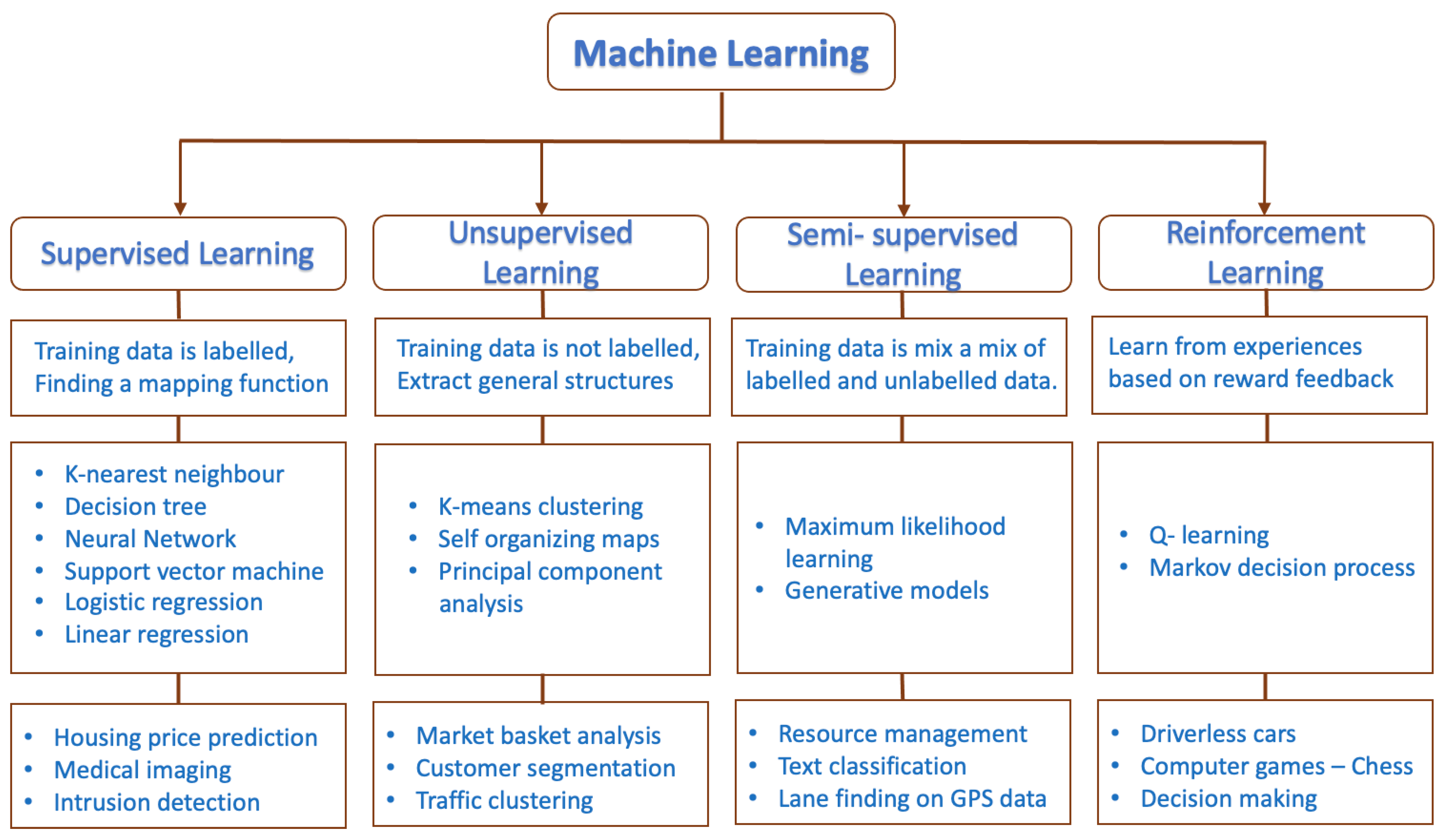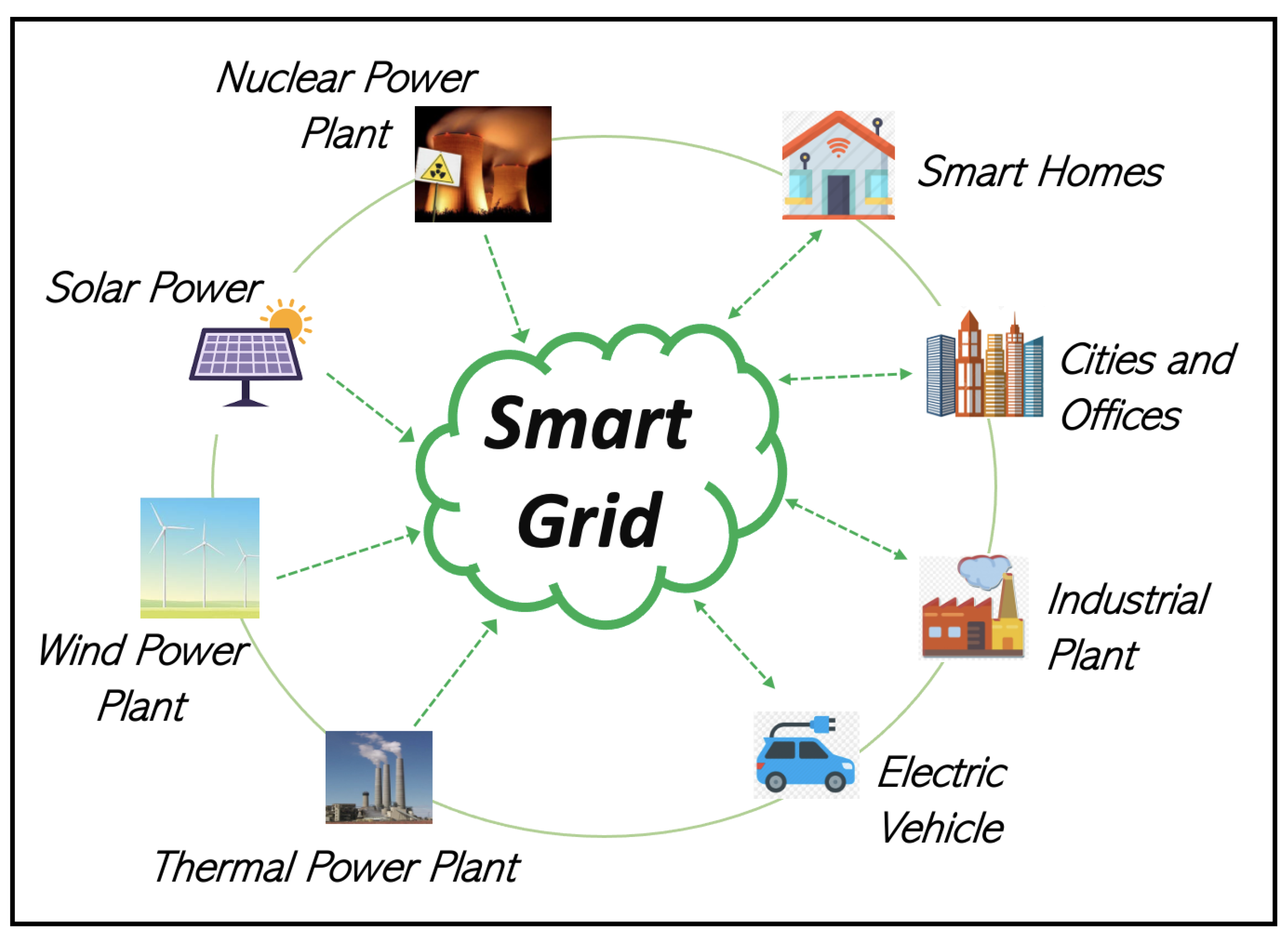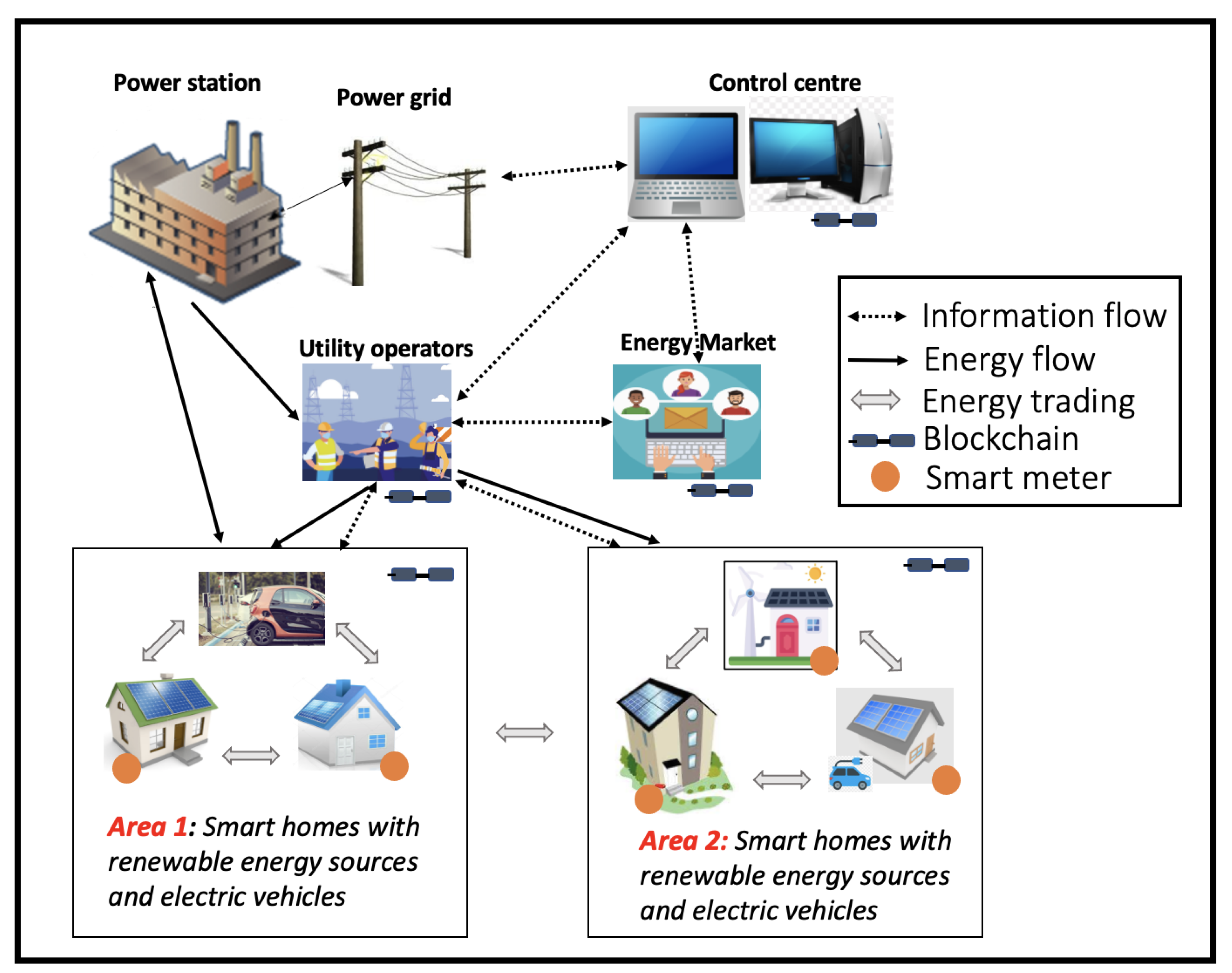
| Version | Summary | Created by | Modification | Content Size | Created at | Operation |
|---|---|---|---|---|---|---|
| 1 | Vidya Krishnan Mololoth | -- | 3288 | 2023-02-23 13:25:57 | | | |
| 2 | Lindsay Dong | -8 word(s) | 3280 | 2023-02-27 03:11:12 | | |
Video Upload Options
A wide range of solutions, beyond the classical one of building more lines, cables and transformers, have been proposed to modernize the power grid with new technologies, enabling a more smart automatic networked system. These solutions, typically using new technology, go by the name “smart grids” (SG) or “smart-grid technology”. Blockchain technology (BC) is a viable solution to overcome the issues of centralized system. BC is an immutable, distributed and P2P network that provides security, privacy and trust among peers using cryptographic techniques. Machine learning (ML) techniques can be exploited to develop energy prediction algorithms and the proper scheduling of energy usage. A large amount of the energy consumption data of several users is generated from smart meters that also contain users’ private/confidential information as well as sensitive information of utility providers. This high volume of data increases the complexity of data analysis.
1. Introduction
1.1. Smart Grids
Traditionally, the term grid is referred to an electrical system that supports the generation, transmission, distribution and trading of electricity. Figure 1 shows an example of a traditional power grid. A traditional grid transports the electricity generated by large power plants to the electricity consumers. In the distribution network, the energy flow is only in one direction. However, there is a need to replace the electricity from fossil fuel (coal and gas mainly) and manage the increased electrification (EVs, but also in certain industrial processes) that results in higher consumption. Hence, alternative energy sources are required, i.e., RES. Traditional grids have only limited capability to incorporate these sources.

1.2. Blockchain Technology
1.3. Machine Learning

2. Blockchain in Smart Grids
The use of BC technology in the energy sector is a key research topic nowadays. As the energy industry is undergoing tremendous transformations with the adoption of ICT, it has become a prominent research area. Intelligent grid implementation with minimal power loss, high power quality, reliability and security are the main goals to be attained.
The distributed architecture of SG is depicted in Figure 3. However, maintaining all these distributed functionalities by a single centralized server is complex and highly vulnerable [13]. The ultimate aim of all the transformations in the grid is to reform the existing energy industry by bringing producers and consumers closer to each other using distributed generation and resources. In centralized systems, all the users, energy operators and market system interactions are dependent on central entities. These intermediaries can monitor, control and support all activities within the elements in the grid [14]. Additionally, the long-distance transmission network is opted to deliver energy to end users through distribution stations. The increase in the number of elements associated with the grid raises some concerns [15], which include scalability, reliability, availability, communication overhead and so on. All of these issues point toward the need for a decentralized structure for energy grids to create a more dynamic and flexible grid structure [16].

Security, energy management, EV charging and energy trading are also some of the areas to be transformed and implemented effectively. As users are becoming prosumers through distributed generation, they can trade electrical energy to other grid users. Traditional methods fail to provide a secure and flexible energy trading platform [17] where users can trust each other. Due to privacy and security concerns, most of the users show less interest in participating in energy trading. Hence, a decentralized platform which can create a trust environment for secure energy trading is required. Indeed, the penetration of EVs also has effects, as energy trading between EVs can also be done [18].

2.1. Energy Trading

2.2. Electric Vehicles
2.3. Demand Response Management
Several research works explore different techniques to develop an innovative DRM system with the adoption of BC technology. The main idea of most of the works was to develop a secure trading platform for distributed prosumers and EVs. Smart contracts which can execute upon reaching desired conditions gained great acceptance in the DR application [33][34][35][36][37][38][39][40]. Some of the works which aims to develop better DR prototypes are listed in Table 1.
| Ref | Major Contribution | Technologies Used |
|---|---|---|
| [27] | Proposes an EV charging scheme in a BC-enabled SG system which minimizes power fluctuation level in grids and charging cost for EV users (AdBev scheme) | Ethereum, smart contracts |
| [33] | Investigate use of BC mechanism in demand management by setting up decentralized P2P energy flexible marketplace | Smart contracts |
| [34] | Design a BC based secure energy trading framework (SETS), having security and privacy preservation to manage demand response management (DRM) | Ethereum, smart contracts, Etcoins |
| [35] | Explains an algorithm for secure DRM in SGs using BC that helps to take efficient energy trading decisions for managing overall grid load | Energy coins, PoW |
| [36] | Proposes a secure model for energy trading using BC, contract based incentive mechanism for load balancing and route optimization algorithm to reduce EV traveling time. | Consortium BC, Proof of Work based on Reputation (PoWR), shortest route algorithm |
| [37] | Proposes a decentralized cooperative DR framework to manage the daily energy exchanges within a community of Smart Buildings and allows participants to decide on day-ahead community power profile, subsequently ensures the forecast tracking during the next day. | Ethereum, smart contracts |
| [38] | Proposes an energy scheduling scheme among multiple microgrids, EV energy scheduling integrated with microgrid operation and introduces a contribution index to prosumers and whole microgrids for prioritizing in auction. | Smart contracts |
| [39] | Introduces a BC-based transactive energy(TE) auction model with incorporated DR techniques for increasing social welfare. | Smart contracts |
| [40] | Addresses the sustainable microgrid design problem by leveraging BC technology to provide the real time-based demand response programs. | Smart contracts |
| [41] | Proposes an optimal power flow based DRM system without any central authority | Smart contracts |
2.4. Security and Privacy
3. Machine Learning in Smart Grids
3.1. Attack Detection and Security
3.2. Data Analysis
3.3. Demand Response Management
4. Integration of Blockchain and Machine Learning for Smart Grids
| Ref | Major Contribution | Technical Resources |
|---|---|---|
| [49] | Evaluate the development of a decentralized EV charging infrastructure using BC, AI and SGs | - |
| [50] | Proposes a decentralized electricity trading framework (DETF) for connected EVs. | Hyperledger, smart contracts, predictive bidding |
| [51] | Proposes DeepCoin, a BC and DL based framework to protect SGs from cyber attacks. | Recurrent neural networks, Hyperledger, PBFT |
| [52] | Explains P2P trading system for sustainable power supply in SGs using BC and ML | Hyperledger, smart contract, PBFT, Predictive model using LSTM |
| [53] | Explains an intelligent EV charging system for new energy companies using consortium BC | Smart contracts, Limited Neighborhood Search with Memory (LNSM) algorithm |
| [54] | Proposes an energy trading approach using machine learning and blockchain technology | Smart contracts K-nearest neighbor |
References
- Baimel, D.; Tapuchi, S.; Baimel, N. Smart Grid Communication Technologies. J. Power Energy Eng. 2016, 4, 1–8.
- NIST Framework and Roadmap for Smart Grid Interoperability Standards. 2021. Available online: http://www.nist.gov (accessed on 10 June 2021).
- Gharavi, H.; Ghafurian, R. Smart Grid: The Electric Energy System of the Future. Proc. IEEE 2011, 99, 917–921.
- Nakamoto, S. Bitcoin: A Peer-to-Peer Electronic Cash System. 2021. Available online: https://papers.ssrn.com/sol3/papers.cfm?abstract_id=3440802 (accessed on 15 July 2021).
- Sengupta, J.; Ruj, S.; Bit, S.D. A Comprehensive Survey on Attacks, Security Issues and Blockchain Solutions for IoT and IIoT. J. Netw. Comput. Appl. 2020, 149, 102481.
- Wood, G. Ethereum: A secure decentralised generalised transaction ledger. Ethereum Proj. Yellow Pap. 2014, 151, 1–32.
- Ethereum. 2021. Available online: https://ethereum.org/en/ (accessed on 8 July 2021).
- Buterin, V. A next-generation smart contract and decentralized application platform. Ethereum White Pap. 2014, 3, 1–36.
- Solidity. Introduction to Smart Contracts. 2021. Available online: https://docs.soliditylang.org/en/v0.8.17/ (accessed on 8 July 2021).
- Dhillon, V.; Metcalf, D.; Hooper, M. The Hyperledger Project. In Blockchain Enabled Applications; Springer: New York, NY, USA, 2017.
- Liu, Y.; Yu, F.R.; Li, X.; Ji, H.; Leung, V.C. Blockchain and machine learning for communications and networking systems. IEEE Commun. Surv. Tutor. 2020, 22, 1392–1431.
- Tanwar, S.; Bhatia, Q.; Patel, P.; Kumari, A.; Singh, P.K.; Hong, W.C. Machine Learning Adoption in Blockchain-Based Smart Applications: The Challenges, and a Way Forward. IEEE Access 2020, 8, 474–488.
- Musleh, A.S.; Yao, G.; Muyeen, S.M. Blockchain Applications in Smart Grid-Review and Frameworks. IEEE Access 2019, 7, 86746–86757.
- Mollah, M.B.; Zhao, J.; Niyato, D.; Lam, K.Y.; Zhang, X.; Ghias, A.M.Y.M.; Koh, L.H.; Yang, L. Blockchain for Future Smart Grid: A Comprehensive Survey. IEEE Internet Things J. 2021, 8, 18–43.
- Wu, J.; Tran, N.K. Application of blockchain technology in sustainable energy systems: An overview. Sustainability 2018, 10, 3067.
- Zhang, S.; Lee, J.H. Analysis of the main consensus protocols of blockchain. ICT Express 2020, 6, 93–97.
- Dorri, A.; Luo, F.; Kanhere, S.S.; Jurdak, R.; Dong, Z.Y. SPB: A Secure Private Blockchain-Based Solution for Distributed Energy Trading. IEEE Commun. Mag. 2019, 57, 120–126.
- Kang, J.; Yu, R.; Huang, X.; Maharjan, S.; Zhang, Y.; Hossain, E. Enabling Localized Peer-to-Peer Electricity Trading Among Plug-in Hybrid Electric Vehicles Using Consortium Blockchains. IEEE Trans. Ind. Inform. 2017, 13, 3154–3164.
- Agung, A.A.G.; Handayani, R. Blockchain for Smart Grid. J. King Saud Univ. Comput. Inf. Sci. 2020, 34, 666–675.
- Hassan, N.U.; Yuen, C.; Niyato, D. Blockchain Technologies for Smart Energy Systems: Fundamentals, Challenges, and Solutions. IEEE Ind. Electron. Mag. 2019, 13, 106–118.
- Ante, L.; Steinmetz, F.; Fiedler, I. Blockchain and energy: A bibliometric analysis and review. Renew. Sustain. Energy Rev. 2021, 137, 110597.
- Kim, S.K.; Huh, J.H. A Study on the Improvement of Smart Grid Security Performance and Blockchain Smart Grid Perspective. Energies 2018, 11, 1973.
- Hertz-Shargel, B.; Livingston, D. Assessing Blockchain’s Future in Transactive Energy. 2019. Available online: http://www.jstor.org/stable/resrep24585.1 (accessed on 23 September 2022).
- Andoni, M.; Robu, V.; Flynn, D.; Abram, S.; Geach, D.; Jenkins, D.; McCallum, P.; Peacock, A. Blockchain technology in the energy sector: A systematic review of challenges and opportunities. Renew. Sustain. Energy Rev. 2019, 100, 143–174.
- Fraiji, Y.; Azzouz, L.B.; Trojet, W.; Saidane, L.A. Cyber security issues of Internet of electric vehicles. IEEE Wirel. Commun. Netw. Conf. 2018, 2018, 1–6.
- Huang, X.; Xu, C.; Wang, P.; Liu, H. LNSC: A Security Model for Electric Vehicle and Charging Pile Management Based on Blockchain Ecosystem. IEEE Access 2018, 6, 13565–13574.
- Liu, C.; Chai, K.K.; Zhang, X.; Lau, E.T.; Chen, Y. Adaptive Blockchain-Based Electric Vehicle Participation Scheme in Smart Grid Platform. IEEE Access 2018, 6, 25657–25665.
- Knirsch, F.; Unterweger, A.; Engel, D. Privacy-preserving blockchain-based electric vehicle charging with dynamic tariff decisions. Comput. Sci. Res. Dev. 2018, 33, 71–79.
- Su, Z.; Wang, Y.; Xu, Q.; Fei, M.; Tian, Y.C.; Zhang, N. A secure charging scheme for electric vehicles with smart communities in energy blockchain. IEEE Internet Things J. 2019, 6, 4601–4613.
- Kim, M.; Park, K.; Yu, S.; Lee, J.; Park, Y.; Lee, S.W.; Chung, B. A secure charging system for electric vehicles based on blockchain. Sensors 2019, 19, 3028.
- Sun, G.; Dai, M.; Zhang, F.; Yu, H.; Du, X.; Guizani, M. Blockchain-Enhanced High-Confidence Energy Sharing in Internet of Electric Vehicles. IEEE Internet Things J. 2020, 7, 7868–7882.
- Samuel, O.; Javaid, N.; Shehzad, F.; Iftikhar, M.S.; Iftikhar, M.Z.; Farooq, H.; Ramzan, M. Electric vehicles privacy preserving using blockchain in smart community. In Proceedings of the International Conference on Broadband and Wireless Computing, Communication and Applications, Antwerp, Belgium, 7–9 November 2019; Springer: Cham, switzerland; pp. 67–80.
- Pop, C.; Cioara, T.; Antal, M.; Anghel, I.; Salomie, I.; Bertoncini, M. Blockchain based decentralized management of demand response programs in smart energy grids. Sensors 2018, 18, 162.
- Kumari, A.; Gupta, R.; Tanwar, S.; Tyagi, S.; Kumar, N. When Blockchain Meets Smart Grid: Secure Energy Trading in Demand Response Management. IEEE Netw. 2020, 34, 299–305.
- Jindal, A.; Aujla, G.S.; Kumar, N.; Villari, M. GUARDIAN: Blockchain-Based Secure Demand Response Management in Smart Grid System. IEEE Trans. Serv. Comput. 2020, 13, 613–624.
- Yahaya, A.S.; Javaid, N.; Javed, M.U.; Shafiq, M.; Khan, W.Z.; Aalsalem, M.Y. Blockchain-Based Energy Trading and Load Balancing Using Contract Theory and Reputation in a Smart Community. IEEE Access 2020, 8, 22168–22218.
- Cutsem, O.V.; Dac, D.H.; Boudou, P.; Kayal, M. Cooperative energy management of a community of smart-buildings: A Blockchain approach. Int. J. Electr. Power Energy Syst. 2020, 117, 105643.
- Meghana, P.; Yammani, C.; Salkuti, S.R. Blockchain technology based decentralized energy management in multi-microgrids including electric vehicles. J. Intell. Fuzzy Syst. 2022, 42, 991–1002.
- Kalakova, A.; Zhanatbekov, A.; Surash, A.; Nunna, H.K.; Doolla, S. Blockchain-based decentralized transactive energy auction model with demand response. In Proceedings of the IEEE Texas Power and Energy Conference (TPEC), College Station, TX, USA, 2–5 February 2021; pp. 1–6.
- Tsao, Y.C.; Thanh, V.V.; Wu, Q. Sustainable microgrid design considering blockchain technology for real-time price-based demand response programs. Int. J. Electr. Power Energy Syst. 2021, 125, 106418.
- Merrad, Y.; Habaebi, M.H.; Toha, S.F.; Islam, M.R.; Gunawan, T.S.; Mesri, M. Fully Decentralized, Cost-Effective Energy Demand Response Management System with a Smart Contracts-Based Optimal Power Flow Solution for Smart Grids. Energies 2022, 15, 4461.
- Esmalifalak, M.; Liu, L.; Nguyen, N.; Zheng, R.; Han, Z. Detecting stealthy false data injection using machine learning in smart grid. IEEE Syst. J. 2017, 11, 1644–1652.
- Teichgraeber, H.; Brandt, A.R. Clustering methods to find representative periods for the optimization of energy systems: An initial framework and comparison. Appl. Energy 2019, 239, 1283–1293.
- Hossain, E.; Khan, I.; Noor, F.U.; Sikander, S.S.; Sunny, M.S.H. Application of Big Data and Machine Learning in Smart Grid, and Associated Security Concerns: A Review. IEEE Access 2019, 13960–13988.
- Pallonetto, F.; Rosa, M.D.; Milano, F.; Finn, D.P. Demand response algorithms for smart-grid ready residential buildings using machine learning models. Appl. Energy 2019, 239, 1265–1282.
- Mansoor, M.; Grimaccia, F.; Leva, S.; Mussetta, M. Comparison of echo state network and feed-forward neural networks in electrical load forecasting for demand response programs. Math. Comput. Simul. 2021, 184, 282–293.
- Combining Blockchain with Machine Learning: Benefits and Challenges. 2022. Available online: https://www.knowledgenile.com/blogs/combining-blockchain-with-machine-learning-benefits-and-challenges/ (accessed on 6 December 2022).
- Kumar, N.M.; Chand, A.A.; Malvoni, M.; Prasad, K.A.; Mamun, K.A.; Islam, F.; Chopra, S.S. Distributed Energy Resources and the Application of AI, IoT, and Blockchain in Smart Grids. Energies 2020, 13, 5739.
- Elhusseini, H.; Assi, C.; Moussa, B.; Attallah, R.; Ghrayeb, A. Blockchain, AI and Smart Grids: The Three Musketeers to a Decentralized EV Charging Infrastructure. IEEE Internet Things Mag. 2020, 3, 24–29.
- Said, D. A decentralized electricity trading framework (DETF) for connected EVs: A blockchain and machine learning for profit margin optimization. IEEE Trans. Ind. Inform. 2020, 17, 6594–6602.
- Ferrag, M.A.; Maglaras, L. DeepCoin: A Novel Deep Learning and Blockchain-Based Energy Exchange Framework for Smart Grids. IEEE Trans. Eng. 2020, 67, 1285–1297.
- Jamil, F.; Iqbal, N.; Imran, S.A.; Kim, D.H. Peer-to-Peer Energy Trading Mechanism Based on Blockchain and Machine Learning for Sustainable Electrical Power Supply in Smart Grid. IEEE Access 2021, 9, 39193–39217.
- Fu, Z.; Dong, P.; Ju, Y. An intelligent electric vehicle charging system for new energy companies based on consortium blockchain. J. Clean. Prod. 2020, 261, 121219.
- Ashfaq, T.; Khalid, M.I.; Ali, G.; Affendi, M.E.; Iqbal, J.; Hussain, S.; Ullah, S.S.; Yahaya, A.S.; Khalid, R.; Mateen, A. An Efficient and Secure Energy Trading Approach with Machine Learning Technique and Consortium Blockchain. Sensors 2022, 22, 7263.




